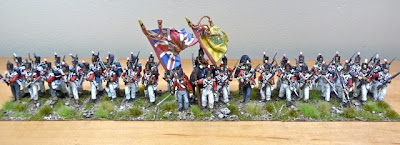The first group of these figures (ten, I think) originated from my earlier days in the hobby and I decided last spring that I wanted to enlarge and rebase them so they better aligned with the look and feel of our 'Big Battalion' games. So here is the regiment, fresh with replacements, (24 strong) ready to be deployed on the tabletop.
The early Carabinier uniform is one of my favorites of the period as, to me, it personifies both the elegance and power of the French heavy cavalry at that time. Sure, the later brass cuirass and crested helmet was very fashionable and quite swish but I think it lacked the understated grace of the long-tailed cutaway coat, white waistcoat and tall bearskin bonnet.
It is believed that the regiment retained a high proportion of aristocrats from the ancien regime which may have helped it maintain a greater level of professionalism during that early period when the French cavalry typically suffered from a lack of experienced officers (at this time the guillotine was very busy providing 'advancement opportunities' to meritorious NCOs and junior officers).
An interesting anecdote from this early period is during 1800, when the 1st Carabiniers were billeted in the small German town of Eichstadt. The impoverished town was so strained under the burden of French taxes that it faced the prospect of having to sell its sacred vessels from the local church in order to raise sufficient funds. On hearing of this situation the Carabinier officers first tried to get the debt reduced, and failing that, passed the hat amongst themselves in order to pay the debt from their own pockets. For years afterward, long after the French were considered to be the arch enemies to all Germans, the grateful town of Eichstadt celebrated an annual mass for the 1er Regiment de Carabiniers a Cheval.
A little known but dramatic action involving the Carabiniers occurred early in the 1809 campaign when they faced against their equivalent in the Austrian Cuirassiers in a moonlit melee near the village of Alt Egolfsheim. The Austrians were covering the retreat of their infantry after the Battle of Eckmuhl to which the French were vigorously pursuing. The Austrian Gottensheim Regiment of Cuirassiers led the charge and were met with a short range volley of carbine fire from the 1er Regiment de Carabiniers, who then slung their firearms, drew swords and charged. The combination of their numbers, training and superior mounts allowed the French to prevail. (John Elting writes that the quality of the enormous Flemish and Norman horses was telling against the largely untrained remounts of the Austrian troopers)
The French heavy cavalry was used ruthlessly by Napoleon during the vicious battles of Aspern-Essling and Wagram. The cuirassiers and Carabiniers were often sacrificed to fill gaps or to buy time for the infantry to redeploy.
After the shocking losses they suffered during the 1809 campaign it was decided to equip the Carabiniers conforming with the regulations of the rest of the heavy cavalry arm, that is with helmets and full cuirass. With typical Gallic elan the Carabinier troopers received the news of them being issued armour rather poorly, thinking it to be an insult to their honour and courage and it took no small amount of convincing to have them surrender their beloved bearskins and long coats.
These are relatively older Foundry castings but they are still amongst the best depicting this early Carabinier uniform. I expect that either Victrix or the Perry's (if not both) will come out with a new rendition in the years to come.
Above is a small conversion to a cavalry casualty figure depicting a Carabinier trooper who has been shot from his horse which is gamely galloping forward with the charge.
As these larger cavalry units can be a bit of a nuisance to move around the table I decided to place them into movement trays that Sylvain kindly mocked-up for me in card. We decided to break them over two sections to facilitate both the extended line and supported line formations which were common doctrine at the time.
I think I have enough castings in 'the lead stocks' to do the 2nd Regiment but I'm afraid that'll be down the road as I need to get another Dragoon regiment done to fill out a proper brigade - but more on that later!
(Information from John Elting's Swords Around A Throne, David Johnson's Napoleon's Cavalry and its Leaders, James Arnold's Crisis on the Danube and Napoleon: His Life, His Wars, His World vol. 10. Illustration buy Angus McBride.)
(Information from John Elting's Swords Around A Throne, David Johnson's Napoleon's Cavalry and its Leaders, James Arnold's Crisis on the Danube and Napoleon: His Life, His Wars, His World vol. 10. Illustration buy Angus McBride.)
















